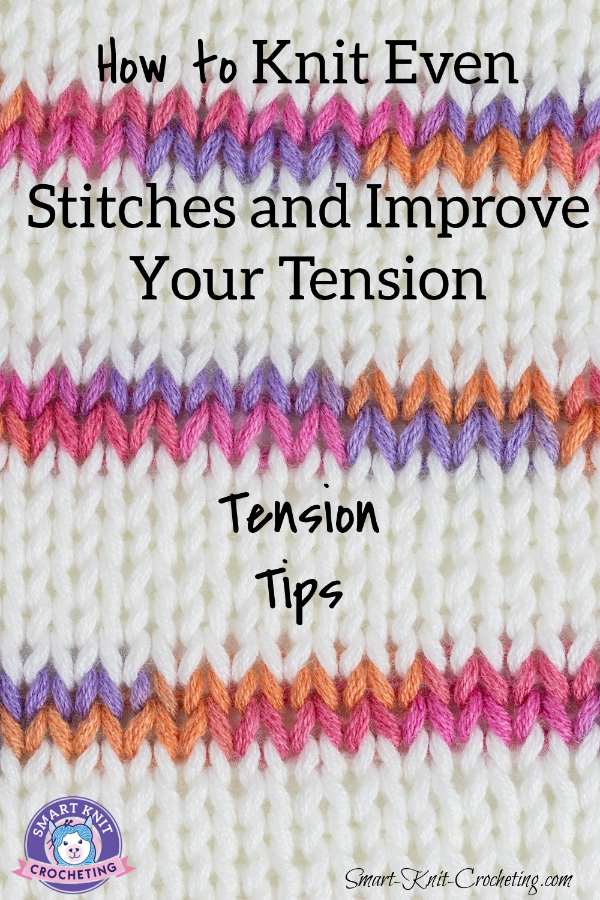- Home
- How to Knit: Basics
- Knit Even Stitches
How to Knit Even Stitches: Tips for Solving Knitting Tension Problems
How to Knit Even Stitches: by Janice Jones
You know you have become a serious knitter when you begin to notice uneven stitches. Some are larger than others. Some rows have spaces between them.
Sometimes your cast on or bind off rows appear too tight or too loose, or maybe it is the side stitches or selvages that look uneven and unruly. If any of these problems occur, you know you have some Tension issues that need to be addressed.
Knitting tension problems can occur in three different areas:
- When you knit from row to row
- When you cast on or bind off
- When you knit or purl the first and last couple of stitches in a row.
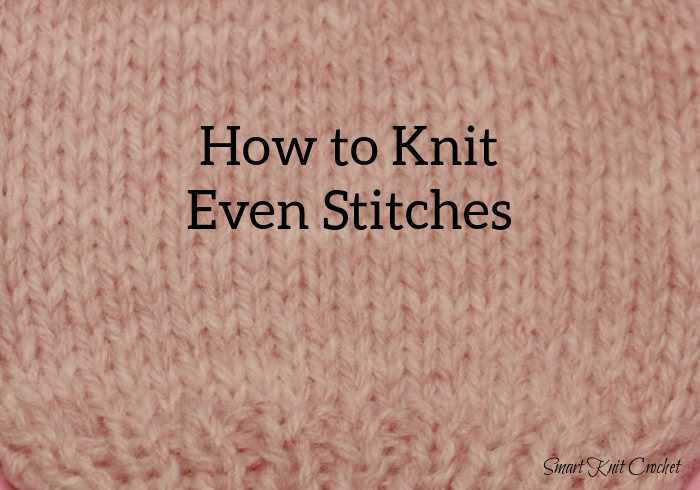
What causes Knitting Tension Problems or Uneven Stitches
Most of the problems occur because of how we control our yarn. That is how we hold the yarn in our hands and how we knit. There is no one right way to knit, but there are two significant ways that most knitters in the western world hold their yarn.
These methods can be broken down into Continental and Englisher knitters.
Continental knitters hold and control the yarn in their left hand, while English knitters hold and handle it in their right hands. You may have heard of the terms pickers and throwers.
Pickers are continental knitters, and throwers are English knitters. Both methods are totally acceptable and fine, and most people choose an approach based on how they were taught.
If we hold the yarn in such a way to prevent a smooth flow through our fingers, we may end up knitting too tight.
Likewise, if the yarn flows too fast, the stitches may be too loose. But that is not the only reason why our knitted stitches may be uneven.
What Causes Knit Stitches to be Uneven?
It goes without saying that you should be in a comfortable position where you are not too hot or too cold when you knit. In addition, your hands should be clean, not sweaty or so dry that you can’t manipulate the yarn.
There are several reasons why stitches might not be even:
Fiber Choice
Some yarns show stitches very well. Wool is a type of yarn where stitches are easy to see. Other novelty yarns, including those that are heathered, other types of wool such as cashmere and alpaca tend to be harder to knit with, and they are hard to see stitches. Mohair or angora are not considered smooth, and stitches won’t be easy to detect.
Some beautiful yarns such as heathers, speckled, variegated, or tweed yarns may not show your stitches, so it’s hard to see where your problems land. Novelty yarns may be fun, but their texture makes it impossible to see how even your stitches are, and if you can’t see the stitches, you can’t make them even.
Each type of yarn is labeled according to how much it weighs—the finer the yarn, the smaller the stitches. The thickest yarns, such as super bulky yarns, create huge stitches.
Some yarns are labeled according to ply, such as 2 ply, 4 plies, etc. This refers to the number of individual strands that are sued to make up the yarn. Ply can affect tension because the individual strands are twisted on themselves. When knitting, some ply's can break apart or split and produce different sizes than those where the ply twist is still intact.
Needle Size
The larger the needle, the looser the tension even within the same type of yarn. To get a tighter tension to match the gauge of the pattern you are using, you may need to go down a needle size or two.
Needle Types
Normally, needles are made out of wood/bamboo, plastic or some form of synthetic materials, or metal such as aluminum or steel. Steel needles are the smoothest, and yarn flows across the needle quickly.
There does not seem to be as much friction on the stitches, so knitters may end up having a looser tension on steel needles. Wood or Bamboo needles tend to hold the stitches tighter, and there is less likely that stitches can easily fall off of these needles.
Many writers recommend bamboo or wood for beginning knitters for this reason. Since stitches require a bit more effort to glide over these needles, the tension may be tighter using this type of needle.
Plastic, nylon, acrylic, or other manufactured materials are used in making different types of needles. These needles tend to grab the yarn better than steel or aluminum. They may be suitable for beginners and those wishing to improve their tension.
Mood or Stress
Mood or stress can also have a significant effect on stitch pattern tension. If the knitter is exceptionally relaxed, the tension is also likely to be relaxed, possibly creating a knitting swatch that may have an uneven tension.
If, on the other hand, the knitter is stressed, the tension is likely to be very tight because the knitter is creating very tight stitches.
Mood and stress go hand in hand. A happy knitter is expected to be relaxed, and a depressed knitter may be more stressed. Unfortunately, we are not always aware of our stress level.
The takeaway to this issue is to become mindful of your mood when you knit.
Knitting is supposed to be fun and relaxing. If you are so stressed when you begin, you are unlikely to achieve the health benefits that accompany this craft. One way to avoid this issue is to think of knitting as a form of meditation.
Concentrate on your breathing as well as your overall muscle tension. Do a few deep breathing exercises before you begin. Find a place and time where you can concentrate on your knitting.
How to Knit Even Stitches
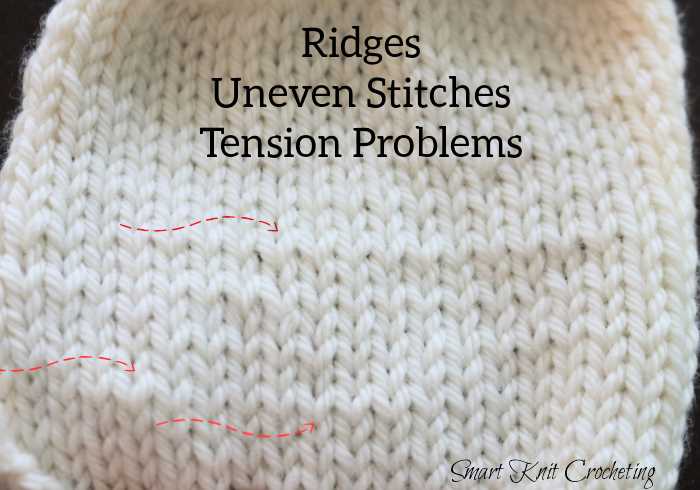
One of the most telling tension problems occurs in the stockinette stitch (knit one row, purl one row). You can notice the problem on both sides of the fabric.
On the right or public sides, uneven stitches look like larger or smaller stitches related to those around them. As a result, the entire row of stitches will often look bigger or looser than the row before or after.
These are called ridges. On the wrong side of the fabric, you will see spaces between the rows. These are called gutters and are evident if you look at the purl or wrong side.
Before we can figure out how to improve, our knitted stitches are even needed to determine what we are doing wrong.
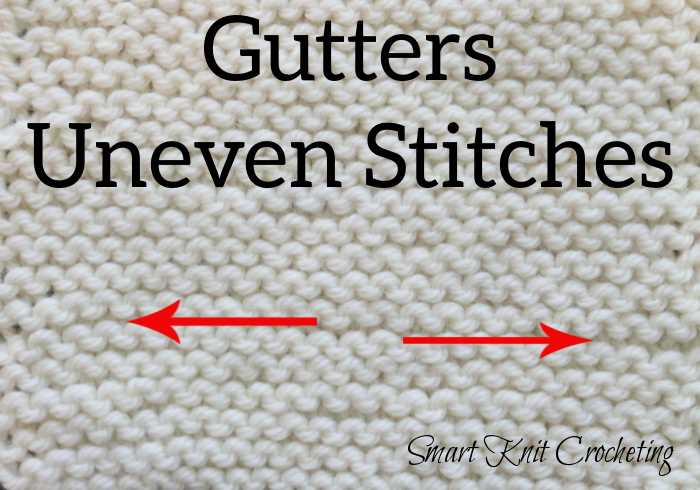 To Knit even stitches means to eliminate gutters on the wrong side of the fabric.
To Knit even stitches means to eliminate gutters on the wrong side of the fabric.In a project that requires stockinette stitches, it may be easy to figure out what we’re doing wrong. Want to learn what’s causing your uneven stitches? Great.
Start by finding some yarn of the same size and thickness in two different colors.
Using a wool or wool blend is most helpful in two light-colored yarns to do this little experiment. Next, choose a pair of knitting needles that would be appropriate for the weight of the yarn based on the information on the yarn ball label.
Project to Determine Tension Problems
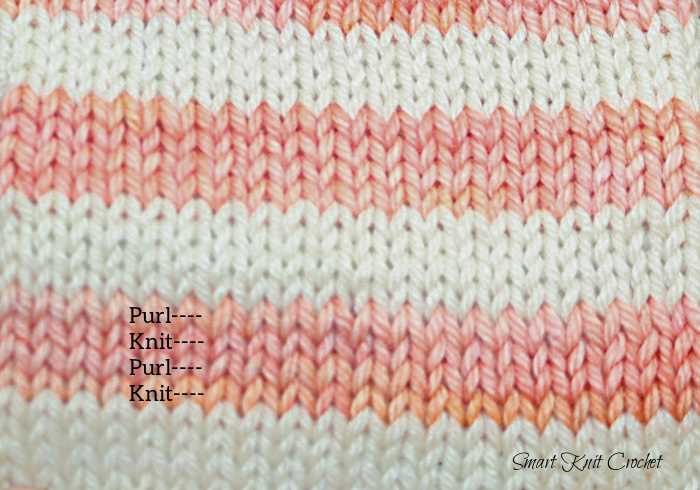 Learn how to knit even stitches by doing this experiment
Learn how to knit even stitches by doing this experimentI chose a Merino Wool Superwash Yarn in size 4 standard weight and size 7 needles in this experiment.
Cast on 20 stitches.
Beginning with a Purl row, knit 4 rows in the standard stockinette pattern
R1: Purl
R2: Knit
R3: Purl
R4: Knit
Changes colors
R5: Purl
R6: Knit
R7: Purl
R8: Knit
Stop and take a look at your work on both the right and the wrong side of the work: Answer these questions?
View and Analyze Your Work
Are all stitches the same size?
Are some larger or stick out more than others on the right side?
Are there some spaces or gutters between rows on the wrong side?
Count the rows. If rows 2, 4, 6, and 8 are larger than the other rows, you are knitting looser than purling.
If the opposite is true (i.e., rows 1, 3, 5, 7 are looser, then your purl stitches are looser. )
It is not unusual for continental knitters to purl looser than knit and vice versa for English knitters.
If you find that your purl stitches are looser, the obvious fix is to tighter the purl stitches. Of course, the opposite is true of knit stitches, but just how do you do that?
If your Purl stitches are looser/ if your Knit stitches are looser, consider one of these solutions.
To tighten Purl Stitches and Loosen Knit Stitches
Continental vs. English Knitting. Try a different way of knitting. If you are a picker, try throw one stitch type and picking the other type. For example, Pick your purl stitches (Continental method) and Throw your knit stitches (English method). Do the opposite if your knit stitches are too loose.
Combination knitting. This type of method combines western and eastern type knitting. In the west, such as in North America and Western Europe, we may either knit continental or English. Either way, we make purl stitches by wrapping the yarn around the needle from front to back or counter-clockwise. We make knit stitches similarly, inserting our needles into the front leg of the stitch and wrapping the yarn from front to back.
For knitters that use the continental knitting style, the combined method may produce a more even tension because purl stitches tend to use more yarn and may create a looser stitch. Combined knitting creates both knit and purl stitches that use about the same amount of yarn.
Creating purl stitches using the combined method is also much easier when using the continental method. There is less finger and wrist motion.
Entrelac Knitting: If you can maintain even tension by knitting all stitches, but when you make purl stitches, your tension is uneven, knitting in a manner where you are knitting forward and backward, making only knit stitches could improve your tension. This method could work if you are making a stockinette stitch on straight needles. If you work on circular knitting needles, knitting every row will even produce a stockinette pattern.
Use two different-sized needles. If large purl stitches are your problem, consider making the row of purl stitches with the next smaller-sized needle. Reverse the sizes if the knit stitches are the culprit.
Circular Needles. If you face the only problem between knitting and purl stitches, an easy fix is to knit with circular needles. When you use circular needles, you will be knitting only, making the garter stitch. Still, the end result will be the stockinette stitch. If your uneven stitches is between knitting and purl stitches, this may be an easy fix.
Other types of Tension Problems
We've discussed how tension problems can cause us to knit uneven stitches especially evident in stockinette fabric.
There are two other places where problems can also occur that are somewhat related to the problems of knitting even stitches. One such problem occurs at the beginning or ending rows where the edge stitches are uneven. Fixing edge stitches means creating columns of stitches that all look the same, meaning they are all the same size.
Problems with tension can also be evident when knitting rows of knit and purl stitches such as in ribbing, cables, and the seed stitch.
How to Knit Even Stitches and Improve Knitting Tension: Last Words
These are just a few suggestions to help you knit even stitches or get your tension under control. Your problem may be related to your cast-on or bind-off methods, and they, too, are tension problems.
Other tension problems involve uneven edge stitches. Both issues can be addressed in a separate article. For this tutorial, we concentrated on stitches within a stockinette pattern that are uneven and how to manipulate them so you will be able to knit even stitches.
Improve Your Tension: Pin for Future Reference
About Janice
Hi, I’m Janice, the voice behind Smart-Knit-Crocheting. I love to knit and crochet and even more, I love teaching others what I know.
Though I learned to knit and crochet as a child, I didn’t get serious about these amazing hobbies until I retired. I’m a certified knit and crochet instructor through the Craft Yarn Council and am working on becoming a Master Hand Knitter through The Knitting Guild Association.
I’m currently living with my husband of over 50 years and our 6 Shih Tzu dogs.
I love hearing from you, so please drop me a line and let me know what you’re working on, whether you love knitting or crocheting more, and if you have any questions. Please visit my about me page for more information.
Happy Crocheting
